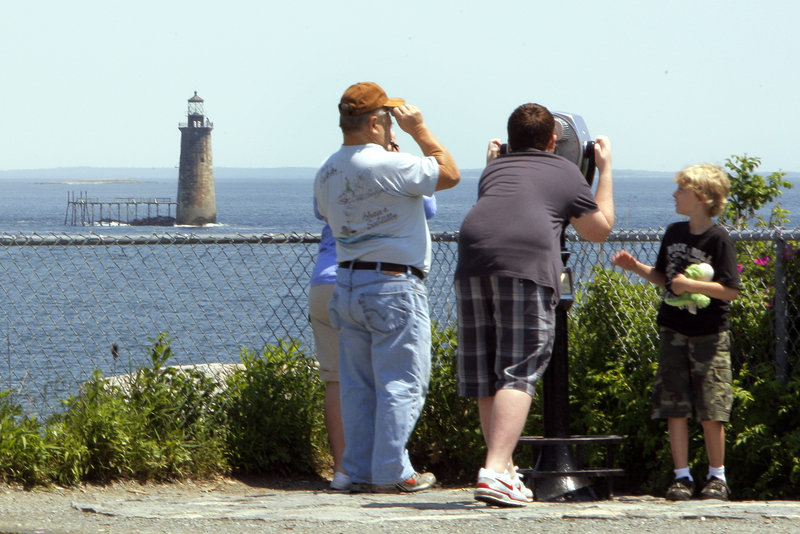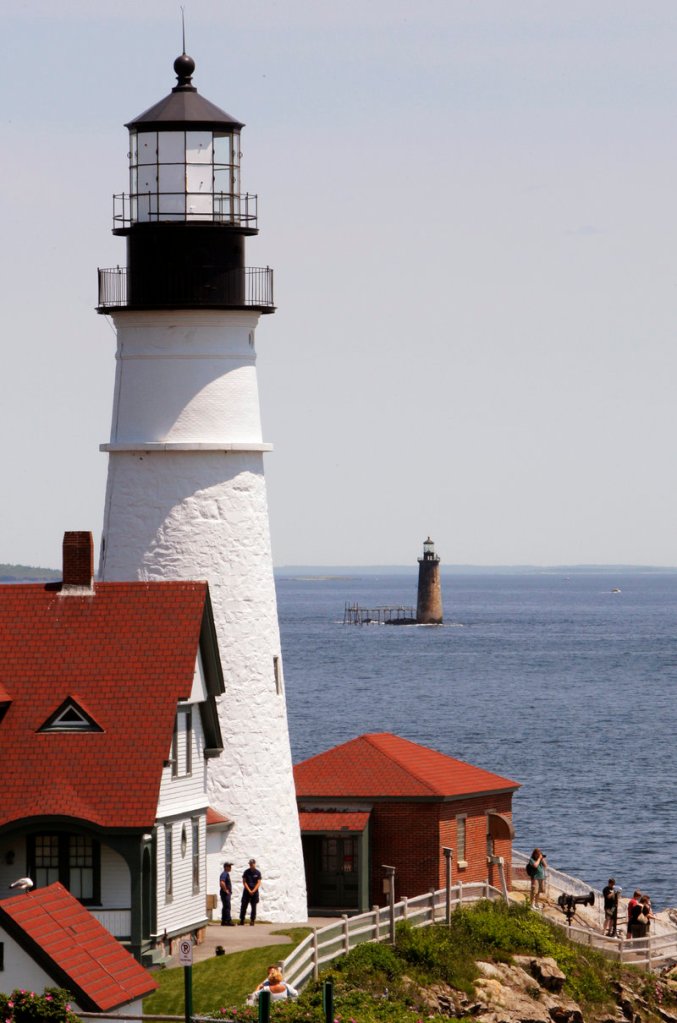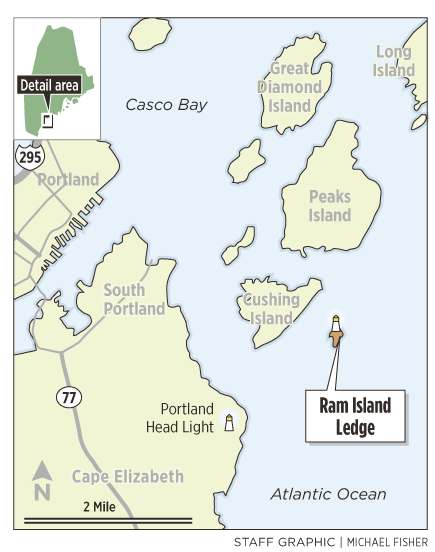What inspires a brain surgeon, who lives in a house in the woods and reportedly doesn’t even own a boat, to plunk down $190,000 at auction for a lighthouse in Portland Harbor?
And what is his plan for preserving the historic Ram Island Ledge Light?
Dr. Jeffrey Florman has the answers, but nine months after he placed the winning bid, he’s keeping a low public profile.
As in, off-the-radar low.
Florman did not respond to requests for an interview last week and has turned down several other requests since the auction closed Sept. 14. At the time, he tried to remain anonymous even after the U.S. General Services Administration released his name to the media.
The bidders who lost to Florman, meanwhile, say they’re interested to see what decisions the Windham resident will make for the unique property.
“I guess being a doctor, he doesn’t really want the public to know much about his private life. I think that’s part of it,” said Portland-based real estate developer Art Girard, who stopped bidding on the lighthouse after losing a gentleman’s coin flip to Florman outside the entrance to Maine Medical Center.
Girard said Florman probably also worries about the public making judgments about him because of his income and profession.
A report published by the Sun Journal of Lewiston a few years ago listed Florman as the highest-paid doctor in Maine, earning $1 million in 2007.
During the bidding war for Ram Island Ledge Light, Florman simply told Girard he wanted to preserve the lighthouse and protect its historic role at the entrance to Portland Harbor, about a mile off Cape Elizabeth.
“He just seemed like a good guy, a quiet guy. Very private,” Girard said.
Girard did not have a specific plan for the lighthouse if he had won. He already owned a small island in Saco and was intrigued by the idea of owning a landmark.
“I thought it would be a cool thing to do, and also I’ve been known to buy things that nobody else wants,” Girard said.
“Doc called it and won,” he said of the coin flip. “A nicer guy couldn’t have won it.”
Bob Muller isn’t as congenial. While he wishes Florman the best and also described him as a nice person, Muller is still stinging from the auction process. He thinks he was the best-qualified suitor in an unexpected bidding war that drove the price well above what it should have been.
“It should have gone for about $75,000 or $100,000 at the most,” said Muller, a high-tech entrepreneur from Harpswell.
Muller created the Ram Island Ledge Lighthouse Project, a collaborative effort to buy the lighthouse by selling ownership stakes in the property for between $35 and $50 online.
“We created a lot of buzz and we raised a lot of money in a short period of time,” Muller said.
“But we did it in the public eye, which caused many people to be aware of the lighthouse who wouldn’t have been aware of it, and who probably shouldn’t have been bidding on it to begin with.”
Muller said his background is in classified government contract work involving digital mapping and remote sensing technologies.
His vision for the lighthouse was to equip it with the most advanced cameras, sound recorders and various instruments. Because the lighthouse sits on dangerous ledges that are battered by waves and storms for much of the year, it would be practically impossible to bring visitors there regularly. Instead, Muller wanted to bring the property to the people via the Internet.
A percentage of the ownership fees would have gone to marine research institutes, lighthouse preservation groups and other organizations chosen by the members, Muller said.
Muller said he tried to pitch his plan to Florman both before and after the auction closed, but Florman wasn’t interested.
“Jeff said he knew people in national historic preservation, at the federal level, and they were going to figure out what to do,” Muller said. “He told me from Day One he wanted to be able to preserve it, but he didn’t have a plan he could articulate at the time.”
LIGHTHOUSE STRUCTURALLY SOLID
Muller said he has spoken to Florman within the past couple of months, and the doctor told him that he had visited the lighthouse and done some initial assessment work of the property.
“I talked to many experts who had been in that lighthouse, and it is one of the most solid from a structural point of view,” Muller said.
He estimated that it would cost around $50,000 to remove the remnants of an old iron pier, and possibly a quarter-million dollars or more to build a new one. Future costs would depend on in-depth structural analyses.
Navigational markers have been used at Ram Island Ledge at least since the 1850s, when an iron spindle was erected there, replaced two decades later with a 50-foot-tall wooden tripod. The markers helped mariners avoid the dangerous outcroppings by staying between Ram Island Ledge and Portland Head at Cape Elizabeth.
Congress funded a lighthouse project in 1902, and three years later the lamp was first lit. With its granite base extending about 20 feet below the water line, the lighthouse is about 90 feet tall.
Keepers were assigned to the station until 1959, when electricity, run underground from Cape Elizabeth, allowed the Coast Guard to operate the light and the foghorn from the mainland.
The federal government, struggling to maintain aging lighthouses and depending on them less because of new technologies, began giving them away or selling them under the National Historic Lighthouse Preservation Act of 2000.
Groups or individuals who take over the properties are required to maintain them in accordance with the National Register of Historic Places. And for working lighthouses like Ram Island Ledge Light, the Coast Guard continues to operate and maintain the light and horn.
COIN FLIP ENDS ‘RIDICULOUS’ PROCESS
Ram Island Ledge Light was offered free to local governments and nonprofit organizations, but there were no takers, primarily because of its treacherous location. Not only is it difficult to get a boat or kayak safely on the ledge, visitors have to climb a 30-foot exterior ladder just to get into the structure.
So last June, the U.S. General Services Administration put the lighthouse up for auction for private bidders.
In the last two weeks of the auction, between Sept. 1 and Sept. 14, the high bid rose incrementally from $30,000 to Florman’s winning bid of $190,000. Toward the end, it was Florman and Girard going head to head. Although the bidders were still anonymous at that point, Muller received tips about the others’ identities, and he called them up, urging them to make a deal.
“I said, ‘This is way overvalued already,’ ” Muller recalled. “Unbeknownst to me, they met and had the flip of the coin. I think they realized it was ridiculous.”
In one of the few interviews he has given since the sale, Florman told the Lakes Region Weekly that he was proud to have made the purchase, and his top concern was historic preservation. He also said he would have to buy a boat to access the lighthouse.
“I’m just a random guy who lives with his family in the woods,” Florman told the weekly. “I’m trying to be under the radar, but it is true, I’m from Windham.”
There’s one clue from a local historic group that indicates Florman might be ready to share more of his thoughts with the public soon.
He’s scheduled to speak Nov. 14 at the Yarmouth Historical Society. The topic is a discussion about the preservation of the lighthouse.
Girard, the real estate developer who lost the coin flip, said he simply told Florman to “enjoy it and use it in good health.”
“He said he’d like to show me the lighthouse someday,” Girard said. “I said I’d like that. I don’t want to bother him, but I’d love to get that call.”
Staff Writer Trevor Maxwell can be contacted at 791-645 or at:
tmaxwell@pressherald.com
Send questions/comments to the editors.






Comments are no longer available on this story